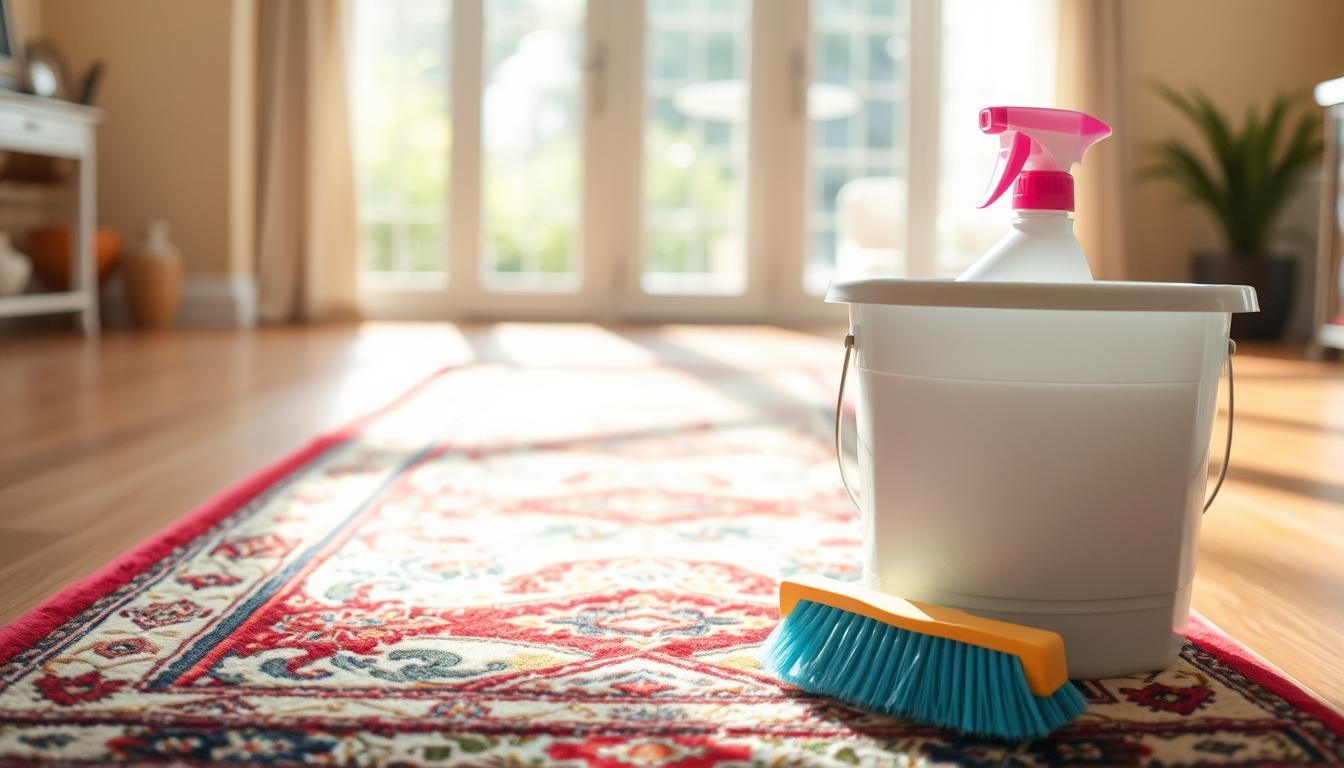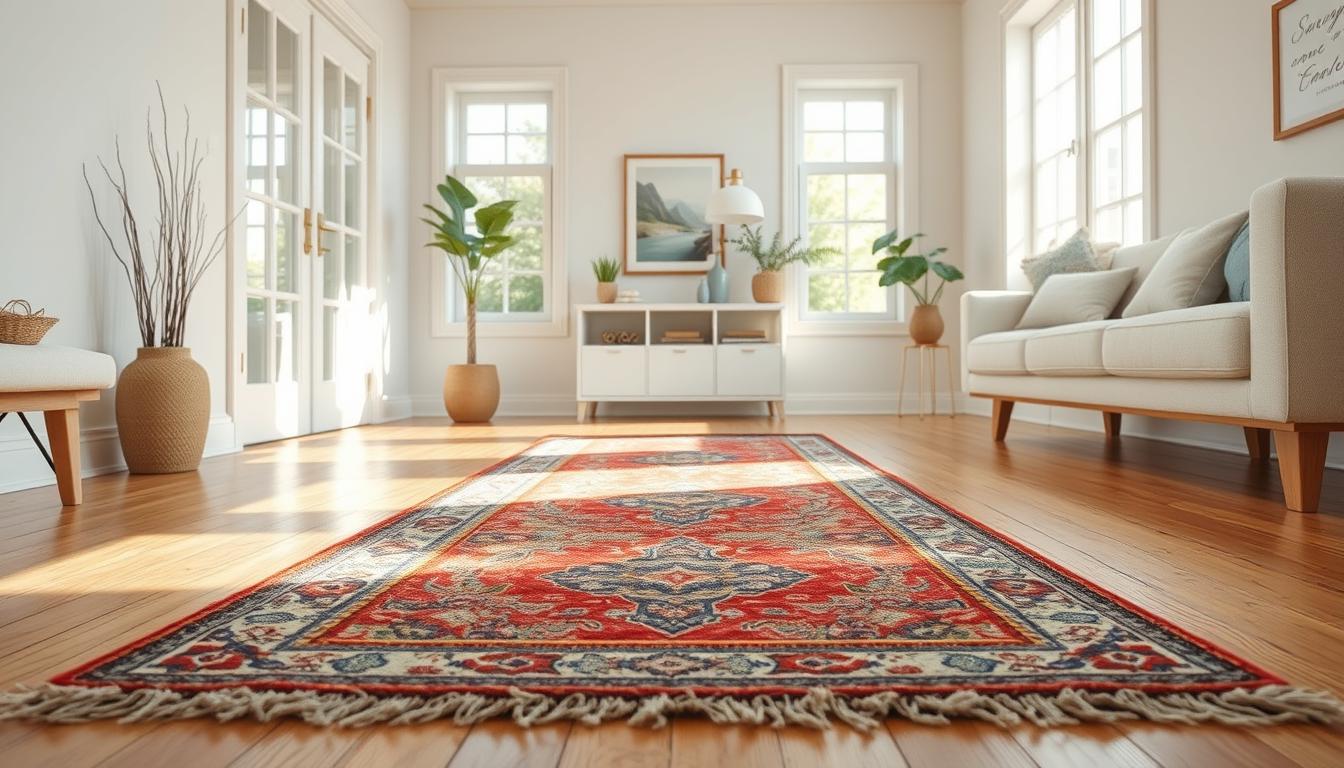
6 Easy Tips to Clean a Runner Rug
That elegant runner tying your space together might hide more than dirt. Beneath its vibrant colors and patterns, allergens, bacteria, and toxins can build up, impacting your indoor air quality. Could neglecting your rugs lead to long-term respiratory issues or faded designs? Let’s explore why care matters beyond just looks.

Dust mites, pet dander, and pollutants settle into area rugs over time, creating an invisible layer of irritants. Liquid spills seep deep, risking stains and color bleeding that dull your rug’s charm. Without proper care, even high-quality rugs lose their freshness—and your home pays the price.
Regular maintenance isn’t just about aesthetics. It removes harmful particles trapped in fibers, safeguarding your family’s health. Professional services handle stubborn spills, while DIY methods preserve intricate details. Either way, consistent care keeps your investment vibrant and functional for years.
Key Takeaways
- Dirty rugs trap allergens and bacteria, affecting air quality and respiratory health.
- Liquid spills cause permanent stains and fading if not treated quickly.
- Deep cleaning eliminates hidden filth, reducing allergy triggers.
- Proper techniques prevent color bleeding, maintaining rug vibrancy.
- Regular care extends rug lifespan and keeps your home fresh.
Essential Preparations for Your Runner Rug Cleaning
Proper setup makes maintenance efficient and effective. Whether tackling spills or refreshing fibers, strategic planning prevents mishaps. Follow these steps to create a foundation for success.

Gathering the Right Tools and Materials
Start with a bucket, warm water, and mild soap. A stiff-bristled brush lifts debris without damaging threads. Keep your vacuum nearby for pre-treatment—its suction power removes loose particles trapped in the backing.
Test cleaning solutions on hidden areas first. Even gentle formulas like Dr. Bronner’s might react with dyes. This simple check preserves vibrant patterns and prevents unexpected fading.
Setting Up Your Cleaning Space
Choose a flat outdoor surface like a driveway. Open-air spots allow thorough rinsing and quick drying. Lay the rug face-down to access its non-slip base during scrubbing.
Sweep or beat the carpet with a broom handle to dislodge stubborn dirt. This step reduces grinding particles into fibers during deep cleaning. Position your tools within reach to maintain workflow momentum.
How to clean Runner Rug: Step-by-Step Guide
Reviving high-traffic textiles requires precision. Follow this systematic approach to remove embedded grime while protecting delicate fibers and dyes.
Targeted Stain Removal Strategies
Blot fresh spills immediately with white cloths. For dried stains, apply water and Dr. Bronner’s soap using clockwise motions. “Gentle agitation prevents color transfer,” notes textile expert Maria Chen. Test solutions on hidden areas before full application.
Full-Saturation Cleaning Method
Position your piece on a level surface like concrete. Flood fibers completely with soapy solution using a garden hose. Scrub systematically—left-right then front-back—with stiff bristles. This dual-direction process lifts deep-seated dirt most effectively.
Final Rinse and Airflow Setup
Flush the textile three times with fresh water, alternating spray angles. Prop it vertically against outdoor chairs with weighted bases for drainage. Rotate midday to accelerate drying. Direct sunlight helps eliminate moisture without fading vibrant patterns when monitored closely.
Indoor and Outdoor Cleaning Strategies for Area Rugs
Your floor coverings face different challenges depending on their location. Indoor fibers trap dust and spills, while outdoor versions battle weather and debris. Tailor your approach to protect each type’s unique structure.

Indoor Carpet and Runner Maintenance
Never toss machine-washable carpet pieces into appliances. The agitation breaks down rubber backings that keep runners stable on floor surfaces. Instead, dab spills with warm water and mild soap using circular motions.
For deeper refreshes, test store-bought cleaners on hidden area sections first. Air-dry flat in a shaded room or use fans—heat sources warp natural fibers. Rotate pieces every 6 months to prevent uneven wear.
Outdoor Rug Care and Spot Cleaning Tips
Hose down synthetic area rugs monthly. Their mold-resistant materials handle full saturation, making outdoor maintenance simpler than indoor versions. For artificial turf, blast leaves away before rinsing.
Skip detergents—sunlight naturally disinfects these durable textiles. Prop vertically against fences to drain excess water quickly. Dry completely before repositioning to avoid musty odors.
Expert Advice on Preserving Colors and Extending Rug Life
Your rug's colors tell a story—one that fades without proper care. Discover how strategic placement and smart maintenance keep patterns vivid for decades.
Maintaining Consistent Colors and Patterns
Many rugs have hidden depth. Flip yours 180 degrees—you might see richer colors suddenly appear. This "light side" effect occurs because fibers reflect natural light differently based on their direction.
| Light Source | Color Impact | Recommended Use |
|---|---|---|
| Natural Light | Enhances vibrancy | Position near windows |
| LED Bulbs | True color display | Evening illumination |
| Fluorescent | Washes out tones | Avoid near rugs |
Rotate your piece every six months. This simple way prevents uneven fading from sunlight exposure. For stubborn odors, sprinkle baking soda generously after drying completely. Let it bask in sunlight for two hours before vacuuming.
Avoiding Common Cleaning Pitfalls
Harsh chemicals destroy dye bonds over time. Instead, use pH-neutral solutions tested on hidden carpet sections first. Blot—never scrub—fresh spills immediately with white cloths.
Professional cleaners restore 78% of faded rugs according to Textile Conservation Journal. Their color-reviving techniques work best when combined with proper home care. Store unused pieces rolled—never folded—to prevent permanent creases.
Remember: prevention beats restoration. A well-maintained rug retains 90% of its original charm after ten years. Your way of handling spills today determines tomorrow's vibrancy.
Conclusion
Your floor coverings transform spaces while collecting life’s messes. With the right approach, you’ll protect their beauty and your home’s air quality. Whether tackling spills or refreshing fibers, consistency makes all the difference.
Weekly vacuuming and prompt stain treatment prevent long-term damage. Remember: indoor runners with rubber backing hate washer machines. Outdoor pieces thrive with simple hosing—no detergents needed. Each type demands tailored care for lasting vibrancy.
Many find unexpected joy in reviving textiles. Watching grime lift under a water jet or seeing patterns regain their pop delivers instant satisfaction. For delicate materials like wool, consult our specialized care guide to avoid shrinkage.
When stains outsmart DIY efforts, professionals restore 78% of faded rugs according to industry studies. Their expertise saves time and preserves heirlooms. Your floors deserve attention—whether through your hands or theirs.
FAQ
Can I machine wash delicate or vintage rugs?
Check the care label first. Hand-washing is safer for fragile fibers. Use cold water and mild detergent to preserve colors. Air-dry flat to avoid stretching.
How often should outdoor carpets be deep cleaned?
Clean outdoor rugs every 2–3 months. Dirt buildup can weaken fibers. Power wash synthetic materials but avoid soaking natural fibers like jute.
What removes tough stains without fading patterns?
Blot spills immediately with a microfiber cloth. Mix white vinegar and baking soda for organic stains. Test solutions on hidden areas first.
Do indoor and outdoor rugs require different care?
Yes. Outdoor styles handle more moisture and UV exposure. Indoor carpets need gentle vacuuming and prompt spill treatment to protect dyes.
Can sunlight cause colors to look dull?
Prolonged UV exposure bleaches dyes. Rotate rugs seasonally. Use UV-blocking window films or move items away from direct sunlight.
Is power washing safe for all materials?
Avoid natural fibers like wool or sisal. Synthetic polypropylene or recycled plastic rugs withstand pressure washing. Keep nozzles 12 inches away.
Why does my rug smell musty after washing?
Trapped moisture breeds mildew. Dry thoroughly outdoors or with fans. Sprinkle baking soda before vacuuming to neutralize odors.
How do I stop edges from curling on runner rugs?
Use rug pads with grip. Steam or iron edges on low heat with a pressing cloth. Store rolled, not folded, to maintain shape.









